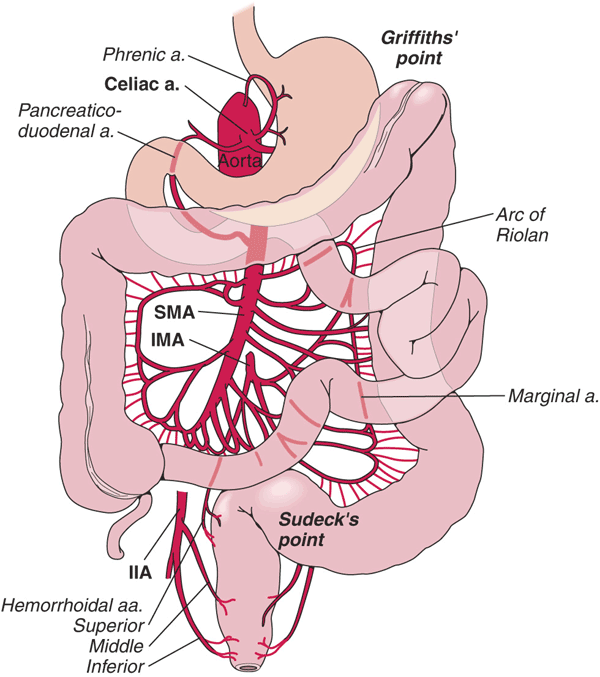Sandbox 2
Lower GI bleeding is defined as any bleed that occurs distal to the ligament of Treitz.
Incidence
- In the United States the incidence of LGIB ranges from 20.5 to 27 per 100,000 persons per year.
Age
- There is a greater than 200 fold increase from the third to the ninth decade of life.
Classification
- Lower GI bleeding can be classified into 3 groups based on the severity of bleeding:
- Occult lower GI bleeding
- Moderate lower GI bleeding
- Severe lower GI bleeding
Blood supply
- The SMA and IMA are connected by the marginal artery of Drummond.
- This vascular arcade runs in the mesentery close to the bowel.
- As patients age, there is increased incidence of occlusion of the IMA.
- The left colon stays perfused, primarily because of the marginal artery.
| Lower GI Tract | Arterial Supply | Venous Drainage | |
|---|---|---|---|
| Midgut |
|
|
|
| Hindgut |
|
|
|
| ɸ -Except lower rectum, which drains into the systemic circulation. | |||

Source: By Anpol42 (Own work) [CC BY-SA 4.0 (https://creativecommons.org/licenses/by-sa/4.0)], via Wikimedia Commons
Pathogenesis
Diverticulosis is the most common etiology of lower GI bleeding accounting for 30% of all cases, followed by anorectal disease, ischemia, inflammatory bowel disease (IBD), neoplasia and arteriovenous (AV) malformations.
- Diverticulosis
- The colonic wall weakens with age and results in the formation of saclike protrusions known as diverticula.
- These protrusions generally occur at the junction of blood vessel penetrating through the mucosa and circular muscle fibers of the colon.
- Diverticula are most common in the descending and sigmoid colon.
- Despite the majority of diverticula being on the left side of the colon, diverticular bleeding originates from the right side of the colon in 50% to 90% of instances.
- Most of the time bleeding from diverticulosis stops spontaneously, however, in about 5% of patients, the bleeding can be massive and life-threatening.

Source:By Anpol42 (Own work) [CC BY-SA 4.0 (https://creativecommons.org/licenses/by-sa/4.0)], via Wikimedia Commons
- Anorectal disease
- Hemorrhoids and anal fissures are the most common disease under anorectal disease responsible for GI bleeding.
- Hemorrhoids are engorged vessels in the normal anal cushions. When swollen, this tissue is very friable and susceptible to trauma, which leads to painless, bright red bleeding.
- Anal fissures are defined as a tear in the anal mucosa. With the passage of stool, the mucosa continues to tear and leads to bright red bleeding.
- Mesenteric Ischemia
- Mesenteric ischemia results when there is inadequate blood supply at the level of the small intestine.
- 2 or more vessels (celiac, SMA, or IMA) must be involved for symptoms to occur.
- Non Occlusive MI affects critically ill patients who are vasopressor-dependent.
- Venous thrombosis of the visceral vessels can also precipitate an acute ischemic event.
- Ischemic Colitis
- Ischemic colitis is caused by poor perfusion of the colon, which results in the inability of that area of the colon to meet its metabolic demands.
- It can be gangrenous or nongangrenous, acute, transient, or chronic.
- The left colon is predominantly affected, with the splenic flexure having increased susceptibility.
- Intraluminal hemorrhage occurs as the mucosa becomes necrotic, sloughs, and bleeds.
- Damage to the tissue is caused both with the ischemic insult as well as reperfusion injury.
- Inflammatory Bowel Disease
- In Crohn's disease T cell activation stimulates interleukin (IL)-12 and tumor necrosis factor (TNF)-a, which causes chronic inflammation and tissue injury.
- Initially, inflammation starts focally around the crypts, followed by superficial ulceration of the mucosa.
- The deep mucosal layers are then invaded in a noncontinuous fashion, and noncaseating granulomas form, which can invade through the entire thickness of the bowel and into the mesentery and surrounding structures.
- In ulcerative colitis T cells cytotoxic to the colonic epithelium accumulate in the lamina propria, accompanied by B cells that secrete immunoglobulin G (IgG) and IgE.
- This results in inflammation of the crypts of Lieberkuhn, with abscesses and pseudopolyps.
- Ulcerative colitis generally begins at the rectum and is a continuous process confined exclusively to the colon.
- Neoplasia
- Colon carcinoma follows a distinct progression from polyp to cancer.
- Mutations of multiple genes are required for the formation of adenocarcinoma, including the APC gene, Kras, DCC, and p53.
- Certain hereditary syndromes are also classified by defects in DNA mismatch repair genes and microsatellite instability.
- These tumors tend to bleed slowly, and patients present with hemocult positive stools and microcytic anemia.
- Although cancers of the small bowel are much less common than colorectal cancers, they should be ruled out in cases of lower GI bleeding in which no other source is
identified.
- AV Malformation/Angiodysplasia
- In AV malformation direct connections between arteries and veins occur in the colonic submucosa.
- The lack of capillary buffers causes high pressure blood to enter directly into the venous system, making these vessels at high risk of rupture into the bowel lumen.
- In Angiodysplasia over time, previously healthy blood vessels of the cecum and ascending colon degenerate and become prone to bleeding.
- Although 75% of angiodysplasia cases involve the right colon, they are a significant cause of obscure bleeding and the most common cause of bleeding from the small bowel in the elderly.